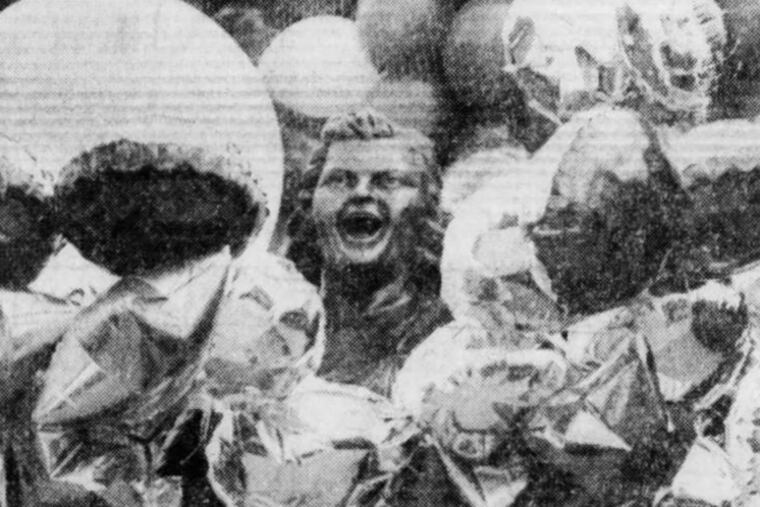Now that the Flyers have removed the Kate Smith statue, what will happen to it?
The Flyers have not disclosed the whereabouts of Smith’s statue or their future plans for the likeness. So what happens to a songstress statue censured?

She came to South Philly wrapped in balloons, a shining piece of Americana heralded from the mountains to the valleys as the Flyers’ “God Bless America”-belting good-luck charm.
Late last week, she left shrouded in black cloth, condemned for racist song lyrics.
After the Flyers ousted Kate Smith’s “God Bless America” from the Wells Fargo Center playlist and removed her larger-than-life bronze likeness from the grounds of Xfinity Live!, one 8-foot-tall question looms: What happens to a songstress statue censured? Does she take up residence down the Shore, or join Gritty in his secret hideout? Is she put in a park for condemned sculptures, or destroyed?
While the Flyers have not disclosed the whereabouts of Smith’s statue or their plans for the likeness, the organization said it removed the sculpture to ensure sentiments from 1930s song lyrics were “no longer echoed," as they were "incompatible with the values of our organization, and evoke painful and unacceptable themes.”
One of the few Philadelphia sculptures of women who actually existed, Smith’s likeness is not the first statue to spark controversy. Here’s what may be in store for the statue’s future.
Welcome in Wildwood
While Smith’s history remains under scrutiny in Philly, she may encounter friendlier faces down the Shore.
Amid outcry against songs Smith performed like “That’s Why the Darkies Were Born” and “Pickaninny Heaven,” Wildwood Mayor Ernie Troiano Jr. told 6ABC that the disgraced statue was welcome in his city.
“If it’s available, we would be interested in having it.... The outcry of the people has piqued my interest," said Troiano, who has also said Smith’s “God Bless America” will continue to play on the Wildwood boardwalk.
Similarly, in the town of North Elba, N.Y., which includes the Olympic village of Lake Placid where Smith is buried, Township Supervisor Roby Politi told WAMC Northeast Public Radio that the municipality would “gladly take Kate’s statue.”
Relocating controversial statues is no new practice. In fact, it’s the eventual plan for the 10-foot-tall, 2,000-pound bronze sculpture of contentious former Police Commissioner and Mayor Frank L. Rizzo.
The likeness of Rizzo (who once honored Smith at City Hall, calling her “a great American, the kind they just don’t make anymore," according to Inquirer archives) is slated to move from its post at Thomas Paine Plaza across from City Hall to a to-be-determined home in the next couple of years.
In both Orlando and Lexington, Ky., Confederate statues were relocated from prominent public spaces to historic cemeteries.
» READ MORE: Wildwood mayor: I won’t stop playing Kate Smith on the boardwalk
A hall of shame
Another option for Smith: placement in a designated area for controversial statues.
A private park in Taiwan has adopted this approach for sculptures from and symbols of the country’s era of authoritarian rule, accepting statue “donations,” some with plaques identifying their source and the reason behind the donation.
In Berlin, the Spandau Citadel has become a “house of disgraced statues,” holding sculptures commemorating Nazis, Prussia, and communism.
» READ MORE: After Kate Smith statue removal, Philadelphia can learn from Taiwan | Opinion
» READ MORE: Take a lesson: How Germany handles monuments from Nazi and communist eras
Out of sight, out of mind?
One common way of handling statues with a tarnished history is placing them — at least temporarily — in storage, away from the public eye.
Such was the case with Pennsylvania State University’s Joe Paterno statue, or Pittsburgh’s sculpture of the minstrel musician Stephen Foster, which was hauled from the city’s Schenley Plaza in April 2018.
And after a 2017 white supremacist rally in Charlottesville, Va., renewed public outcry over keeping Confederate monuments in public places, cities across the country have mothballed their Confederate statues while municipalities decide their fates.
Total meltdown
Perhaps the most unlikely fate of condemned statues: destruction.
In 1998, a not-yet-completed, 35-foot-tall figure of Catherine of Braganza, queen consort of Britain in the 1600s, was melted down for scrap after protests grew over how she benefitted from the slave trade.
After four Confederate monuments were removed from public spaces in Baltimore in 2017, City Councilman Brandon Scott proposed that they be “melted down and repurposed for statues that can show true Baltimoreans and true Americans, great American history.” The statues remain in a secret location until a city task force decides what to do with them.
» READ MORE: Kate Smith a casualty like Joe Paterno, Frank Rizzo | Readers respond
» READ MORE: ‘Knee-jerk reaction’ put Flyers in a corner, triggering removal of Kate Smith statue, former club VP says
» READ MORE: Kate Smith’s racist song is ancient. But so are the wounds it reopened | Editorial